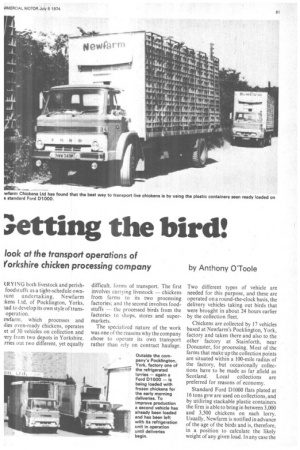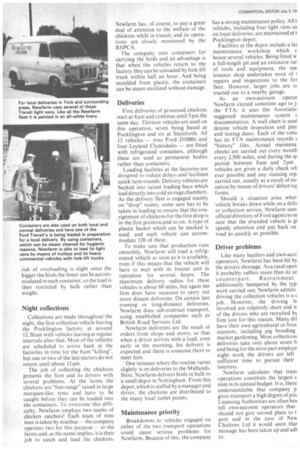;ening the bird!
Page 83

Page 84

If you've noticed an error in this article please click here to report it so we can fix it.
look at the transport operations of forkshire chicken processing company by Anthony O'Toole
RY1NG both livestock and perishfoodstuffs as a tight-schedule own)unt undertaking, Newfarm ;kens Ltd, of Pocklington. Yorks, lad to develop its own style of transoperation.
wfarm, which processes and dies oven-ready chickens, operates et of 30 vehicles on collection and ,ery from two depots in Yorkshire. rries out two different, yet equally difficult, forms of transport. The first involves carrying livestock — chickens from farms to its two processing factories; and the second involves foodstuffs — the processed birds from the factories to shops, stores and supermarkets.
The specialized nature of the work was one of the reasons why the company chose to operate its own transport rather than rely on contract haulage. Two different types of vehicle are needed for this purpose, and these are operated on a round-the-clock basis, the delivery vehicles taking out birds that were brought in about 24 hours earlier by the collection fleet.
Chickens are collected by 17 vehicles based at Newfarm's Pocklington, York, factory and taken there and also to the other factory at Stainforth, near Doncaster, for processing. Most of the farms that make up the collection points are situated within a 100-mile radius of the factory, but occasionally collections have to be made as far afield as Scotland. Local collections are preferred for reasons of economy.
Standard Ford D1000 flats plated at 16 tons gvw are used on collections, and by utilizing stackable plastic containers the firm is able to bring in between 3,000 and 3,500 chickens on each lorry. Usually, Newfarm is notified in advance of the age of the birds and is, therefore, in a position to calculate the likely weight of any given load. In any case the risk of overloading is slight since the bigger the birds the fewer can be accommodated in each container, so the load is then restricted by bulk rather than weight.
Night collections
Collections are made throughout the night, the first collection vehicle leaving the Pocklington factory at around 12.30am with vehicles leaving at regular intervals after that. Most of the vehicles are scheduled to arrive back at the factories in time for the 8am "killing", but one or two of the late starters do not return until about II am.
The job of collecting the chickens presents the firm and its drivers with several problems. At the farms the chickens are "free-range" raised in large marquee-like tents and have to be caught before they can be loaded into the containers. To overcome this diffic.ulty, Newfarm employs two teams of chicken catchers! Each team of nine men is taken by minibus — the company operates two for this purpose -to the farms and, as the name implies, it is their job to catch and load the chickens. Newfarm has, of course, to pay a great deal of attention to the welfare of the chickens while in transit; and its operations are closely monitored by the RSPCA.
The company uses containers for carrying the birds and an advantage is that when the vehicles return to the factory they can be unloaded by fork-lift truck within half an hour. And being moulded from plastic, the containers can be steam sterilized without damage.
Deliveries
First deliveries of processed chickens start at 4 am and continue until 5 pm the same day. Thirteen vehicles are used on this operation, seven being based at Pocklington and six at Stainforth. All 13 vehicles — nine Ford D1000s and four Leyland Clydesdales — are fitted with refrigerated containers, although these are used as permanent bodies rather than containers.
Loading facilities at the factories are designed to reduce delays and facilitate quick turn-rounds. Delivery vehicles are backed into raised loading bays which lead directly into cold storage chambers. As the delivery fleet is engaged mainly on "drop" routes, some care has to be taken in loading to ensure that the consignment of chickens for the first drop is in the first positionand so on. A type of plastic basket which can be stacked is used, and each vehicle can accommodate 320 of these.
To make sure that production runs smoothly, Newfarm will load a refrigerated vehicle as soon as it is available, even if this means that the vehicle will have to wait with its freezer unit in operation for several hours. The maximum delivery radius for these vehicles is about 60 miles, but again the firm does have occasion to carry out more distant deliveries. On certain late evening or long-distance deliveries, Newfarm does sub-contract transport, using established companies such as British Road Services Ltd.
Newfarm deliveries are the result of orders from shops and stores, so that when a driver arrives with a load, even early in the morning, his delivery is expected and there is someone there to meet him.
One instance where the routine varies slightly is on deliveries to the Midlands. Here, Newfarm delivers birds in bulk to a small depot in Nottingham. From this depot, which is staffed by a manager and driver, the chickens are distributed to the many local outlet points.
Maintenance priority
Breakdowns to vehicles engaged on either of the two transport operations could cause serious problems for Newfarm. Because of this, the company has a strong maintenance policy. All t vehicles, including four light vans us on local deliveries, are maintained at t Pocklington depot.
Facilities at the depot include a lar maintenance workshop which c house several vehicles. Being fitted w a full-length pit and an extensive rar of tools and equipment, the ma tenance shop undertakes most of repairs and inspections to the fin fleet. However, larger jobs Care c( tracted out to a nearby garage.
As an own-account operat Newfarm elected sometime ago to ji the FTA; it uses the Associatio suggested maintenance system a documentation. A wall chart is used denote vehicle inspection and plat and testing dates. Each of the vehi( has its FTA maintenance records a "history" files. Actual maintena checks are carried out every month every 2,500 miles, and during the qi period between 8am and 2pm vehicles are given a daily check wh ever possible and any running rep carried out, usually as a result of no cation by means of drivers' defect rer forms.
Should a situation arise when vehicle breaks down while on a delis or collection service, Newfarm uses official directory of Ford agents to m sure that the stranded vehicle is gi speedy attention and put back on road as quickly as possible.
Driver problems
Like many hauliers and own-accc operators, Newfarm has been hit by the drivers shortage. As a rural open it probably suffers more than its ur counterpart. Recruitment additionally hampered by the typ work carried out; Newfarm admits driving the collection vehicles is a c job. However, the driving hi involved are relatively short and IT of the drivers who are recruited by firm join for this reason. Many dri have their own agricultural or lives interests, including pig breeding market gardening. Most collections deliveries take only about seven h and being for the most part employe night work the drivers are left sufficient time to pursue their interests.
Newfarm calculates that trans operations constitute the largest s item in its annual budget. It is, there understandable that company p gives transport a high degree of pri( Licensing Authorities are often hea tell own-account operators that should not give second place to t port and in the case of New Chickens Ltd it would seem thai message has been taken up and adl to.
























































































































































